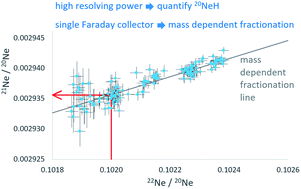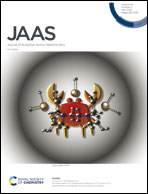The 21Ne/20Ne ratio of atmospheric neon†
Abstract
The atmospheric 21Ne/20Ne ratio has been redetermined. The measurement method has several features, which taken in combination, offer a significant advantage over previous determinations. First, a high mass resolving power (MRP > 6000) was used to permit direct assessment of the amount of the 20NeH interference under measurement conditions. Second, measurements were made by mass jumping on a single detector; this removes any assumptions associated with calibration of a multicollector instrument. Third, a Faraday, rather than electron multiplier detector was used, as this avoids non-linearity (dead time) correction. The NeH/Ne ratio was an order of magnitude lower than other recent studies. Interferences other than NeH were assessed but the use of large sample sizes and high MRP ensured that they were resolved or negligible (effect on 21Ne/20Ne < 10−4 relative). Following convention, the 21Ne/20Ne ratios were corrected for mass dependent fractionation to the value corresponding to 22Ne/20Ne = 0.102, which yields a value for atmospheric 21Ne/20NeFC of (2935.6 ± 0.9) × 10−6 (expanded uncertainty, k = 2). The behaviour of 20NeH in the mass spectrometer was also studied. At higher pressures – as used in the isotope ratio measurements – the amount of NeH was approximately constant. For much smaller Ne samples NeH was proportional to Ne, with 20NeH/21Ne = 0.37% for Ne of atmospheric composition.



 Please wait while we load your content...
Please wait while we load your content...